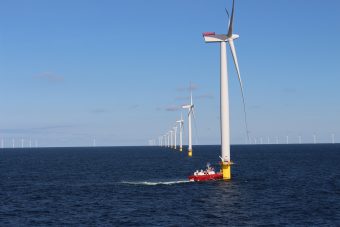
The winds of change are blowing harder in the U.K. The price of energy generated by offshore wind farms has been falling steadily, and ahead of schedule too. Costs have fallen 32 percent since 2012, bringing them below a target of £100 per megawatt-hour previously set by the U.K. government and utilities.
Wind energy wasn’t expected to reach that threshold until 2020, according to the annual Cost Reduction Monitoring Framework report issued by the Offshore Renewable Energy Catapault advocacy group.
Set in 2012, the £100-per-MWh goal ultimately proved conservative, thanks to a variety of factors. The implementation of larger-capacity turbines quicker than anticipated is the likely the largest contributing factor to the cost reduction, according to the report. Other major factors cited by the report included increased competition among wind-farm developers and lower cost of capital.
The number of sites with the potential for development into wind farms now significantly exceeds the funding available from the U.K. government for such projects, the report said. This forced developers to cut costs more aggressively.
As a result, offshore-wind projects finalized in 2015 and 2016 achieved average energy costs of £97 per MWh, compared to £142 per MWh for those finalized in 2010 and 2011. In November 2016, the U.K. government announced its timing for a second round of auctions to distribute funds for new offshore wind-farm projects, to begin in April 2017.
The Offshore Renewable Energy Catapault believes further cost reductions can be achieved as these new projects are approved, but it calls for the government to devise a “set of cost-reduction priorities, timescales, and monitoring processes” to focus the effort.
Governments and utilities are now starting to see the results of years of steady decline in renewable-energy prices. In the U.S., both solar and wind are now cheaper than natural gas, according to the annual Levelized Cost of Energy analysis conducted by investment bank and research firm Lazard.
The renewable sources were found to undercut fossil fuels without subsidies, albeit only in utility-scale installations. Factoring in subsidies lowers the effective cost of electricity produced by wind and solar installations even further.
Source: greencarreports.com

